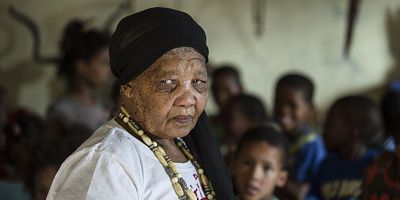South African Children's Book '!Qhoi nla Tjhoi' Hopes to Revive a Dying Ancient Language
Famed 88-year-old South African Khoi-San, N/uu storyteller and writer Katrina Esau has launched Tortoise and Ostrich, the first book published in one of the world's oldest languages.
Photo credit MUJAHID SAFODIEN/AFP via Getty Images
Katrina Esau recently published an old folktale in her native N/uu language of the Khoi-San people, regarded as Africa's first people and whose language spans over thousands of years. Tortoise and Ostrich or !Qhoi nla Tjhoi is the first story written in the almost extinct N/uu language. The book is a history-defining literary debut that evidences Africa's culture of oral storytelling, and encapsulates why the language and the people need to be protected. The book follows Esau's South Africa 2020 National Honorary Award, titled the Order of the Baobab in Silver, for her excellent contribution to the preservation of a language.
Undimmed by her amazing age, Esau spoke about her book in N/uu at the recent launch of Tortoise and Ostrich, hosted by the National Library of South Africa. The children's story is about Ostrich and Tortoise who happen to come across a clay pot and decide to race for it. Tortoise ultimately wins. The story carries with it many wonderous meanings and meanders into friendship, strength, outwitting competition and how the tortoise got its shell — much like many other folktales that were used to teach children about animals, nature and people. According to IOL, Esau wrote the book with the help of her granddaughter Claudia Snyman, and said shewants the book to create an awareness of the N/uu langauge and help take it forward. Snyman translated the book into Afrikaans and English.
Khoi-San languages have been described some of the "critically endangered" languages around the world. Furthermore, the Khoi-San were marked as illiterate by the Dutch colonisers. Esau's book breaks this myth as N/uu is written in its own style and format, characterised by numerous distinct clicks which influenced Nguni languages such as Xhosa and Zulu. The Khoi-San were forced to take on the Afrikaans language and assimilate into the Coloured culture, marking Esau one of only two surviving speakers of the language, according to 702. The beloved grandmother struggles tirelessly for the survival of the language and reportedly hosts weekly classes for 30 to 40 children in Upington, Northern Cape.
Tortoise and Ostrich will, hopefully, chart a path to remembering South Africa's and Africa's authentic identity. Kenyan author Ngũgĩ wa Thiong'o, aged 83 and with over twenty books under his belt, wrote his latest bookThe Perfect Nine in his native Gikuyu. The continent and our dying native languages could definitely benefit from more books being written in vernacular.
Read: The NOMMO Awards Long List Spotlights The Best Of African Speculative Fiction
In 2020, Esau was honoured as a South African Living Human Legend for her ''high degree of knowledge and skills to perform or recreate specific elements of the intangible cultural heritage''. Ostritch and Tortoise will also be translated into SeTswana, IsiZulu, IsiXhosa and the Nama language spoken mostly in Namibia. The Ostrich and the Tortoise is published by New Africa Books and proceeds will go to Esau's ongoing efforts to preserve the language. The book can be purchased online or in person at the Melville-based bookstore Book Circle Capital.
